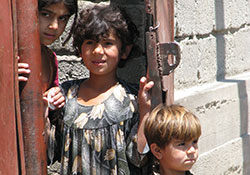WHO response to importation of poliovirus into the WHO European Region, 2010

WHO
In 2010, the WHO European Region experienced the first importation of wild poliovirus into the Region since it was certified as polio-free in 2002.
The Government of Tajikistan reported a sharp increase in cases of acute flaccid paralysis (AFP) in the country in April 2010. AFP – a sudden weakness, paralysis and loss of muscle tone, with no obvious cause (such as trauma) – is the most common sign of poliomyelitis (polio).
WHO sent a team of international experts to Tajikistan on 16 April 2010 to investigate a suspected poliomyelitis (polio) outbreak and to provide technical support to the government, in partnership with the United Nations Children’s Fund (UNICEF) and the US Centers for Disease Control and Prevention (CDC). Genetic sequencing determined that the wild poliovirus type 1 found in Tajikistan is most closely related to viral strains previously identified in Uttar Pradesh, India.
Throughout 2010, Tajikistan reported 457 laboratory confirmed cases of wild poliovirus type 1 (WPV1), including 29 deaths. The outbreak spread to neighboring countries, as well, and in 2010, the Russian Federation reported 14 lab-confirmed cases of poliomyelitis, Turkmenistan 3 cases, and Kazakhstan reported 1 case, all due to WPV1. More than 45 million doses of mOPV1 and tOPV were delivered during outbreak response immunization activities in the Region. The last confirmed case in the Region was reported from the Russian Federation with a date of onset of 25 September 2010.
With the active participation of its partners, WHO has provided technical and field support throughout the duration of the outbreak and will continue to do so until it is brought under control. WHO has also worked closely with the governments of Kazakhstan, Kyrgyzstan, Turkmenistan and Uzbekistan to prevent the possible spread of the outbreak in eastern central Asia.
National immunization days (NIDs) took place in Kazakhstan (two rounds), Kyrgyzstan (two rounds), the Russian Federation (two rounds), Tajikistan (six rounds), Turkmenistan (three rounds), and Uzbekistan (five rounds). These six countries also agreed to synchronize rounds of supplementary immunization activities (SIAs) in spring 2011.



